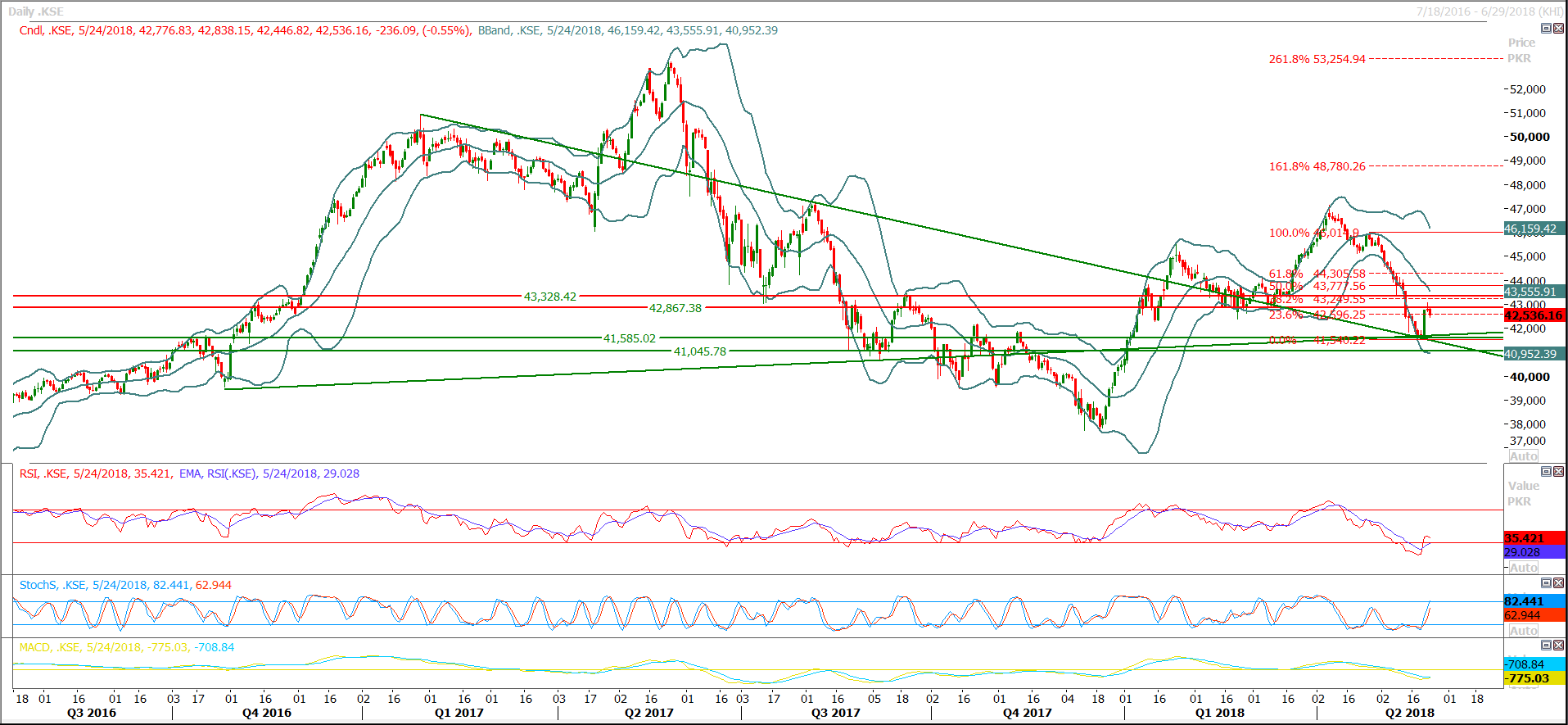Previous Session Recap
Trading volume at PSX floor dropped by 17.49 million shares or 13.76% on DoD basis during last trading session, whereas the benchmark KSE100 Index opened at 42,549.15, posted a day high of 42,570.77 and a day low of 42,000.47 during last trading session. The session suspended at 42,074.09 with net change of -462.07 and net trading volume of 63.1 million shares. Daily trading volume of KSE100 listed companies dropped by 5.89 million shares or 8.54% on DoD basis.
Foreign Investors remained in net buying position of 2.34 million shares but net value of Foreign Inflow dropped by 1.26 million US Dollars. Categorically, Foreign Individuals remained in net selling position of 0.42 million shares but Foreign Corporate and Overseas Pakistanis investors remained in net buying positions of 0.17 and 2.6 million shares. While on the other side Local Individuals, Companies and Mutual Funds remained in net selling positions of 8.65, 1.04 and 2.53 million shares but Local Banks, NBFCs, Brokers and Insurance Companies remained in net buying positions of 3.48, 0.18, 4.47 and 1.51 million shares respectively.
Analytical Review
U.S. stock futures up on North Korea, euro shaken by Italy, oil falls
U.S. stock futures rose on Monday on signs that the United States and North Korea are still working towards holding a summit next month, while oil prices extended losses on expectations of more supply from major producers. The euro edged up from a 6-1/2-month low but is seen vulnerable after efforts to form a coalition government in Italy, the currency bloc’s third-biggest economy, collapsed over the weekend. U.S. S&P500 mini futures rose 0.3 percent in early Asian trade, but market holidays in the world’s two biggest financial centers — London and New York — could make trading slow and illiquid for the day. Japan’s Nikkei gained 0.3 percent in early trade, while South Korea’s Kospi rose 0.5 percent, buoyed by stocks which are seen as benefiting from a further thawing in tensions with Pyongyang. But markets elsewhere in Asia appeared little fazed by the latest North Korean news after a week of conflicting signals from Washington. MSCI’s broadest index of Asia-Pacific shares outside Japan was flat.
Provinces face 65 to 70pc water shortage
The water situation has worsened in the country as water storage came down to 0.22 MAF and the water shortage to the provinces at canal head after conveyance losses have reached to 65 to 70 percent. There is 51 percent shortage is at rim station but at canal head after conveyance losses it would be 65 to 70 percent, said spokesman for Indus River System Authority (Irsa) Khalid Rana in media interaction here. Tarbela is likely to touch dead level within next 24 hours. He said that river inflows on Sunday were 112900 cusecs while the out flows were 119300 cusecs. Talking to media after the IRSA’s meeting, he said that currently Punjab and Sindh are receiving 57500 cusecs and 55000 cusecs respectively with -51 percent shortage, while Balochistan is getting 8000 cusecs (shortage 0 percent) and KP 3100 cusecs (shortage 0 percent).
China plans electric cars in Pakistan
JAC Motor, a Chinese state-owned automobile and commercial manufacturer based in Anhui province, is planning to introduce electric vehicles particular cars, its Deputy Chief Economic Manager David Zhang said. Talking to APP, he said, “We are planning to introduce new energy vehicles particularly electric cars in the Pakistani market under a long term development programme in the future.” Expressing confidence into the current economic situation in Pakistan, he said Pakistan’s economy is now gearing up and there is more improvement in development of infrastructure. He said the management of the company is thinking and aiming at the opportunity to expand its production line in Pakistan.
Rs676b released for uplift projects
The government has released over Rs 676.28 billion under its Public Sector Development Programme (PSDP) 2017-18 for various ongoing and new schemes against the total allocations of Rs 1,001 billion. The released funds include Rs 170.8 billion for federal ministries and Rs 64 billion for special areas, according to latest data released by Ministry of Planning, Development and Reform. Out of these allocations, the government has released Rs 253.98 billion for National Highway Authority for which Rs 324.72 billion have been allocated for the year 2017-18, whereas for WAPDA (Power), an amount of Rs 40.55 billion has been released out of total allocation of Rs 60.9 billion. Similarly, Rs 8.65 billion have been released for Communication Division (other than National Highway Authority) for which the government has earmarked Rs 13.66 billion under PSDP 2017-18. Railways Division received Rs 19.384 billion out of its total allocation of Rs 42.9 billion whereas Aviation Division received Rs 3.39 billion out of its total allocation of Rs 4.348 billion.
Food group imports grow 2.32pc in 10 months
The food group imports grew by 2.32 percent to $5.21 billion during first 10 months of current fiscal year (July-April, 2017-18) compared to the imports worth $5.1 billion during same period of previous year. According to latest data released by Pakistan Bureau of Statistics (PBS), import of milk, cream and milk food also witnessed an increase of 6.48 percent as it surged to $221.266 million in July-April, 2017-18 from $207.798 million in first 10 months of the year 2016-17. The import of dry fruits and nuts, however declined to $97.097 million in the period under review from $148.8 million during same period of last year, showing a decrease of 34.75 percent. The tea import witnessed an increase of 9.04 percent as $492.982 million worth of import was recorded during July-April (2017-18) as compared to the import of $452.11 million during same period of last year.
U.S. stock futures rose on Monday on signs that the United States and North Korea are still working towards holding a summit next month, while oil prices extended losses on expectations of more supply from major producers. The euro edged up from a 6-1/2-month low but is seen vulnerable after efforts to form a coalition government in Italy, the currency bloc’s third-biggest economy, collapsed over the weekend. U.S. S&P500 mini futures rose 0.3 percent in early Asian trade, but market holidays in the world’s two biggest financial centers — London and New York — could make trading slow and illiquid for the day. Japan’s Nikkei gained 0.3 percent in early trade, while South Korea’s Kospi rose 0.5 percent, buoyed by stocks which are seen as benefiting from a further thawing in tensions with Pyongyang. But markets elsewhere in Asia appeared little fazed by the latest North Korean news after a week of conflicting signals from Washington. MSCI’s broadest index of Asia-Pacific shares outside Japan was flat.
The water situation has worsened in the country as water storage came down to 0.22 MAF and the water shortage to the provinces at canal head after conveyance losses have reached to 65 to 70 percent. There is 51 percent shortage is at rim station but at canal head after conveyance losses it would be 65 to 70 percent, said spokesman for Indus River System Authority (Irsa) Khalid Rana in media interaction here. Tarbela is likely to touch dead level within next 24 hours. He said that river inflows on Sunday were 112900 cusecs while the out flows were 119300 cusecs. Talking to media after the IRSA’s meeting, he said that currently Punjab and Sindh are receiving 57500 cusecs and 55000 cusecs respectively with -51 percent shortage, while Balochistan is getting 8000 cusecs (shortage 0 percent) and KP 3100 cusecs (shortage 0 percent).
JAC Motor, a Chinese state-owned automobile and commercial manufacturer based in Anhui province, is planning to introduce electric vehicles particular cars, its Deputy Chief Economic Manager David Zhang said. Talking to APP, he said, “We are planning to introduce new energy vehicles particularly electric cars in the Pakistani market under a long term development programme in the future.” Expressing confidence into the current economic situation in Pakistan, he said Pakistan’s economy is now gearing up and there is more improvement in development of infrastructure. He said the management of the company is thinking and aiming at the opportunity to expand its production line in Pakistan.
The government has released over Rs 676.28 billion under its Public Sector Development Programme (PSDP) 2017-18 for various ongoing and new schemes against the total allocations of Rs 1,001 billion. The released funds include Rs 170.8 billion for federal ministries and Rs 64 billion for special areas, according to latest data released by Ministry of Planning, Development and Reform. Out of these allocations, the government has released Rs 253.98 billion for National Highway Authority for which Rs 324.72 billion have been allocated for the year 2017-18, whereas for WAPDA (Power), an amount of Rs 40.55 billion has been released out of total allocation of Rs 60.9 billion. Similarly, Rs 8.65 billion have been released for Communication Division (other than National Highway Authority) for which the government has earmarked Rs 13.66 billion under PSDP 2017-18. Railways Division received Rs 19.384 billion out of its total allocation of Rs 42.9 billion whereas Aviation Division received Rs 3.39 billion out of its total allocation of Rs 4.348 billion.
The food group imports grew by 2.32 percent to $5.21 billion during first 10 months of current fiscal year (July-April, 2017-18) compared to the imports worth $5.1 billion during same period of previous year. According to latest data released by Pakistan Bureau of Statistics (PBS), import of milk, cream and milk food also witnessed an increase of 6.48 percent as it surged to $221.266 million in July-April, 2017-18 from $207.798 million in first 10 months of the year 2016-17. The import of dry fruits and nuts, however declined to $97.097 million in the period under review from $148.8 million during same period of last year, showing a decrease of 34.75 percent. The tea import witnessed an increase of 9.04 percent as $492.982 million worth of import was recorded during July-April (2017-18) as compared to the import of $452.11 million during same period of last year.
Market is expected to remain volatile therefore it'ss recommended to stay cautious while trading today.
Technical Analysis
The Benchmark KSE100 Index have again reached back to its supportive regions where two trend lines and a horizontal supportive regions are standing to provide support against current bearish run. But this time some extra ordinary pressure could be witnessed on this point because index is moving back in bearish direction after a breath in. On longer time frame index is completing its 61.8% correction on these supportive lines and it’s caged between both bullish and bearish corrections on this point. Index have moved back towards posting a low around 37,000 points and completed 61.8% correction around 46,000 points of its last bearish rally which was started from 53,000 and ended up around 37,000 but it could not closed above its 61.8% correction and now 61.8% correction of its bullish rally is being completed around 41,400 points where these three objects are trying to support index. If index would become able to slide below this correction level then an expansion of last correction would start and this would try to lead index towards 39,200 for a minimum expansion. Therefore it’s recommended to wait for a clear indication of breakout or reversal before initiating new trades.
 To Open picture in original resolution right click image and then click open image in a new tab
To Open picture in original resolution right click image and then click open image in a new tab


0 Comments
No comments yet. Be the first to comment!
Please log in to leave a comment.